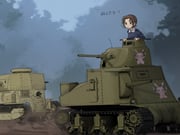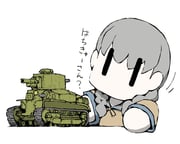type 89 i-gou
Following the Experimental Tank Number 1, which was the first tank to be domestically produced in Japan, the Type 89 medium tank was Japan's first domestically mass-produced tank.
Although the experimental model completed in 1929 (year 2589 of the imperial dating system) was designated as a light tank, its classification soon changed to that of medium tank due to an increase in weight brought about by early modifications.
The tank was divided into two subtypes, the Kou-gata (subtype-A), which was mounted with a water cooled gasoline engine, and the Otsu-gata (subtype-B), mounted with an air cooled diesel engine. The tank's chassis shape, undergoing repeated modifications, can broadly be divided into 4 different types. The majority types were equipped with an unditching tail (In actuality it was mostly used as a storing shelf.)
Although the I-gou was a successful vehicle, its low horsepower and mobility prompted the development of the Type 95 Ha-Gou. It was, moreover, widely inferior to both the Soviet BT-5 and T-26 light tanks used in the battle of Khalkin Gol and the American M3 Stuart light tanks used during the invasion of the Philippines.
See also
External Links
This tag implicates tank (learn more).







